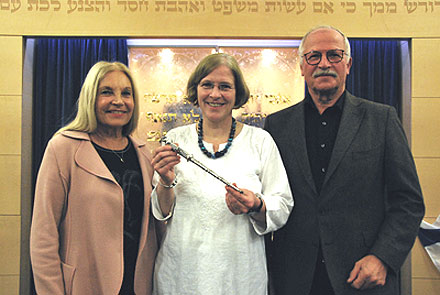| Deister- und Weserzeitung Hamelin |
Return to News Archive December 22, 2019 |
The Wonder of Hanukkah
A Gift for the Reform Jewish Community—An Antique Russian Torah Yad

By Wolfhard F. Truchsess ~ Copyright © Deister- und Weserzeitung 2020
 Rabbi Dr. Ulrike Offenberg holds the more than 200 year old Torah Yad in her hands. It was given to the Jewish community by Alexandra, Traugott and Christian Grundmann |
The first night of Chanukkah in the Reform Congregation of Hamelin was crowned with a symbolic and precious gift which they received from the hands of the Hessisch Oldendorfer couple Alexandra and Traugott Grundmann—a silver Yad made in Russia in 1812. The Yad, as the reading stylus is called in Hebrew, was discovered by Grundmann’s son, Christian, at an “antique auction in Hanover,” Traugott Grundmann explained upon presenting the gift to the community in the synagogue. “Christian was looking for a special piece for our own museum and realized that it could be a Jewish ritual object. That is why he bought the intricately handcrafted sterling silver piece.”
The piece was identified as a Yad, the Hebrew term for Torah pointer, by Alexandra and Traugott Grundmann. “We were familiar with such pointers which are used to show which part of the Torah is being read,” explains Grundmann. “This is due my wife’s interest in Jewish history and Judaism. After all, we live in an old home previously owned by a Jewish family. It was built by Meier Blumenthal in Hessisch Oldendorf in 1892. So it made sense to give the Yad to the Jewish community, especially since we know the Dohme family well, and my wife is good friends with Rachel Dohme, the president of the community. It is also our conviction that the victims of the Nazis be remembered and honored and that we enjoy a good relationship with our fellow Jewish citizens.”
“The Yad is essential for Torah readings and also prevents the parchment and the ink letters from being touched with the fingertip while reading and thus coming into contact with sweat or dirt,” explains Rabbi Dr. Ulrike Offenberg. “In this way, the Yad helps to ensure that the Torah is not extinguished, that the Jewish tradition is preserved, and that the Torah can be passed on to future generations.” The rabbi describes the antique Yad as “particularly symbolic”" because, like many of the members, it is from Russia. Christian Grundmann researched the piece and noted the hallmarks, the silver stamp 84, and that the piece was decorated with the Czar’s eagle. The year 1812 is embossed and two Cyrillic letters are stamped into the stem. The quality indication 84, meaning 84 Zolotniki, is the indication of the silver content common in Russia at the time. The equivalent of 84 Zolotniki means sterling silver.
The fact that the Russian Yad was handed over on Hanukkah had to do with the tradition of this Jewish festival, when gifts are traditionally exchanged. Hanukkah recalls the successful uprising of the Maccabees in the years 167 to 164 B.C.E. against the Greek rule (“before the Common Era,” as